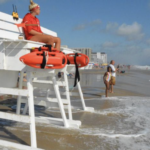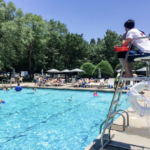As temperatures soar across the United States due to an unprecedented heat wave, the importance of having fully operational and staffed swimming facilities becomes even more critical. The American Lifeguard Association (ALA) has voiced significant concerns about the current lifeguard shortage and its implications for public safety, particularly during extreme weather conditions. This situation is exacerbated by the increased need for safe, supervised swimming areas, as families seek relief from the oppressive heat.
The Heat Wave and Its Consequences
The current heat wave is one of the most severe in recent memory, with temperatures reaching record highs across various states. This extreme weather is not just uncomfortable; it poses serious health risks, including heat exhaustion, heat stroke, and dehydration. Public pools, beaches, and lakes offer a vital respite from the heat, providing a place for families to cool off safely. However, the lifeguard shortage is threatening the safety and accessibility of these recreational spaces.
Lifeguard Shortage: A Growing Concern
The shortage of lifeguards is a nationwide issue that has been growing over the past few years. Several factors contribute to this problem, including the seasonal nature of the job, relatively low wages, and the rigorous training and certification requirements. The COVID-19 pandemic exacerbated the situation, as many certification programs were paused, and potential lifeguards found alternative employment.
The ALA has been actively advocating for better wages, more comprehensive lifeguard training programs, and incentives such as sign-on bonuses to attract and retain lifeguards. Cities like Phoenix and counties like Los Angeles have started implementing measures such as $3,000 sign-on bonuses and increased hourly wages to address the shortage. However, more widespread and coordinated efforts are needed to resolve the issue fully.
Would You Like To Read About: Lifeguard Shortage and Shark Attacks: A Growing Concern in Florida
Importance of Keeping Pools Open and Fully Staffed
Public swimming pools are not just recreational amenities; they are essential public health facilities. During a heat wave, they provide a critical service by offering a safe place for people to cool off. Closed or inadequately staffed pools force families to seek alternative swimming locations, which are often unsupervised and potentially hazardous.
The ALA has noted a sharp uptick in drownings in recent years, correlating with the increased use of unsupervised swimming areas. This trend underscores the importance of maintaining open and fully staffed public pools. Drowning is one of the leading causes of accidental death, particularly among children, and many of these tragedies are preventable with proper supervision and safety measures in place.
Safety Tips from the American Lifeguard Association
To address these concerns, the ALA offers several safety tips for families and individuals seeking to cool off during the heat wave:
- Swim in a Guarded Area: Always choose swimming locations that have lifeguards on duty. Lifeguards are trained to respond quickly and effectively to emergencies, significantly reducing the risk of drowning.
- Never Swim Alone: Swimming with a buddy ensures that someone is always available to help in case of an emergency. This is particularly important for children and inexperienced swimmers.
- Assign a Water Watcher: In group settings, designate a responsible adult to watch the water at all times. This person should avoid distractions and focus solely on monitoring the swimmers.
- Learn CPR and Basic First Aid: In the event of an emergency, knowing how to perform CPR and basic first aid can save lives. The ALA offers training programs that cover these essential skills.
- Follow Pool Rules and Guidelines: Adhering to posted pool rules and guidelines helps ensure a safe environment for everyone. These rules are designed to prevent accidents and injuries.
- Stay Hydrated and Protect Against Sunburn: While enjoying time in the water, it’s easy to forget the need to stay hydrated and protect against sunburn. Drink plenty of water and apply waterproof sunscreen regularly.
- Understand Water Conditions: If swimming in natural bodies of water like lakes or oceans, be aware of the current conditions, including water temperature, tides, and potential hazards like rocks or strong currents.
The Role of the Community
Addressing the lifeguard shortage and ensuring the safety of public swimming areas is not solely the responsibility of government agencies and the ALA. Community involvement is crucial. Local governments, community organizations, and individuals can all play a part in supporting these efforts.
- Local Government Support: Municipalities can allocate funds to increase lifeguard wages and offer incentives for certification. They can also invest in public awareness campaigns to highlight the importance of lifeguards and encourage more individuals to pursue this vital role.
- Community Organizations: Groups like neighborhood associations and local nonprofits can organize fundraising events to support local pools and lifeguard programs. They can also work with schools and youth organizations to promote lifeguarding as a valuable skill and career opportunity.
- Individual Action: Individuals can contribute by encouraging young people to consider lifeguarding as a summer job, volunteering at local pools, or simply by spreading the word about the importance of this issue. Families can also participate in safety training sessions and promote a culture of water safety within their communities.
Conclusion
The heat wave gripping the United States underscores the critical need for safe, supervised swimming areas. The lifeguard shortage poses a significant challenge, but with coordinated efforts from government agencies, community organizations, and individuals, it is a challenge that can be overcome. The American Lifeguard Association continues to advocate for better conditions for lifeguards and greater public awareness of water safety. By following simple safety tips and supporting initiatives to address the lifeguard shortage, we can help ensure that everyone has access to safe places to cool off during these hot summer months.







